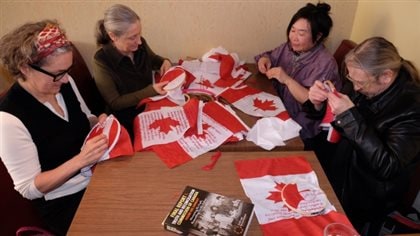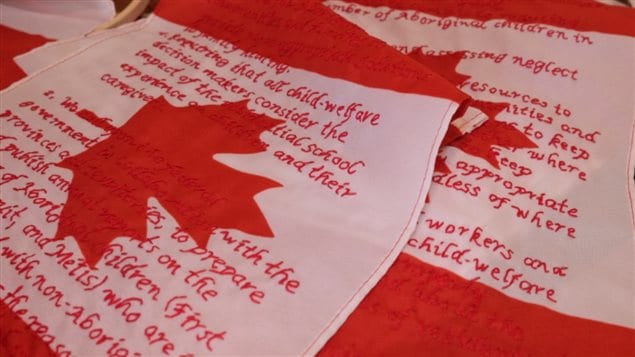Helene Vosters, an artist in Winnipeg, Manitoba, is working on embroidering the 94 Calls to Action that came out of the Truth and Reconciliation Commission, on Canadian flags. It will take 58 to complete.
“It’s a wounding that has happened to us all, that we have been denied histories”

The TRC was the seven year process, from 2008 to 2015, that held hearings across Canada to bring to light the horrific treatment of Canada’s aboriginal peoples in what was known as the residential school system.
Children as young as four or five were taken from their families by police force, and put in boarding schools, usually miles away, so they would have little contact.
As a result children were cut off from their homes, their culture and traditions through elementary school and into high school, when they eventually were old enough to leave on their own.
Punished for speaking their native languages, often severely, hundreds, perhaps thousands of children died from the extreme abuse they suffered. Buried in unmarked graves, relatives still don’t know where they are.
This was just one of the findings of the TRC. Vosters was moved by the report when it was issued in 2015 and had the idea for the flags, but it took a year for her to act on it.
“At first I was a little bit, just not sure about my place. Do I know enough about it? Do I have to be more educated in order to begin this process?” Vosters explained to Holly Caruk of CBC Manitoba.
“Embroidery takes so much time and care and it’s not something that happens quickly, so it began to feel like a real metaphor for me about reconciliation,” Vosters said.
The daughter of immigrant parents Vosters said the reality of residential schools was not something she was ever told about. It wasn’t part of her education, nor that of her parents’ when they were becoming citizens.
“Colonisation is a huge thing to grasp”
“It’s a wounding that has happened to us all, that we have been denied histories,” she said.
She began sewing the words on small flags, about the size of a placemat. Eventually she wanted to share the experience, and make it public.
“It’s meaning was limited doing it alone because reconciliation isn’t about only individual actions. It’s about collective actions,” she told Caruk.
Now she is hosting sewing circles in public spaces, and others have joined eagerly. Joan Suzuki, a teacher, is one of the members of the circle. Sewing is a treasured pastime for her and she appreciated the opportunity to hear more about the TRC’s recommendations.
“Colonisation is a huge thing to grasp. A huge impact on the Indigenous peoples that we can barely fathom what it means,” said Suzuki, who has an interest in Indigenous education.
Suzuki also knew very little about indigenous experiences or the residential school system when she was growing up, but she feels she has a connection with Indigenous history.
“My Japanese roots brought me here because of the evacuation and internment of Japanese people during the Second World War,” she said.
“So I know that that was simultaneously happening while residential schools were happening. Which is a blatant racist action on the part of the Canadian government. That’s where my history merges with Indigenous peoples’ history,” Suzuki said.
At the moment, 18 of the 58 flags are finished and 10 are in progress. When complete, Vosters intends that they be displayed in public, and be brought to schools to initiate discussions.







For reasons beyond our control, and for an undetermined period of time, our comment section is now closed. However, our social networks remain open to your contributions.